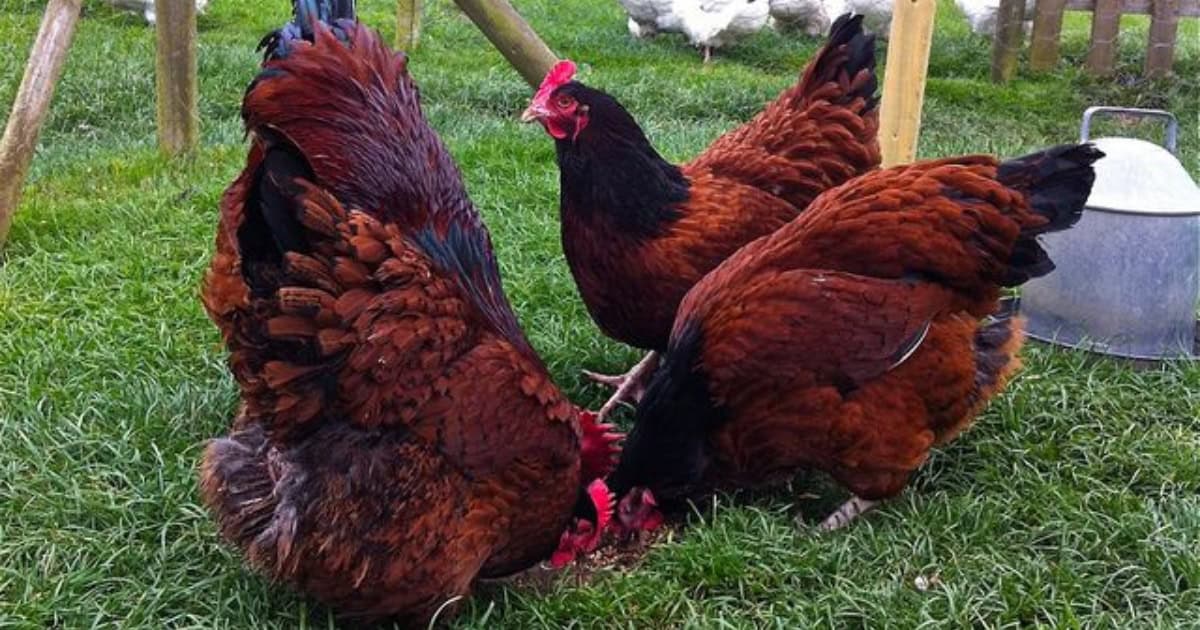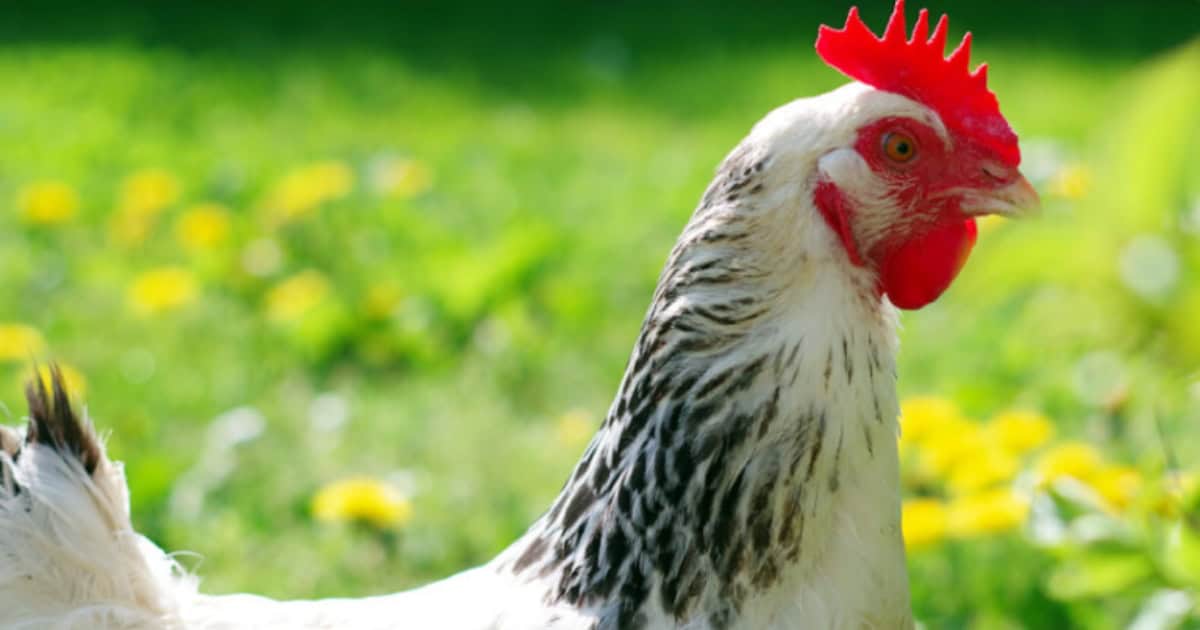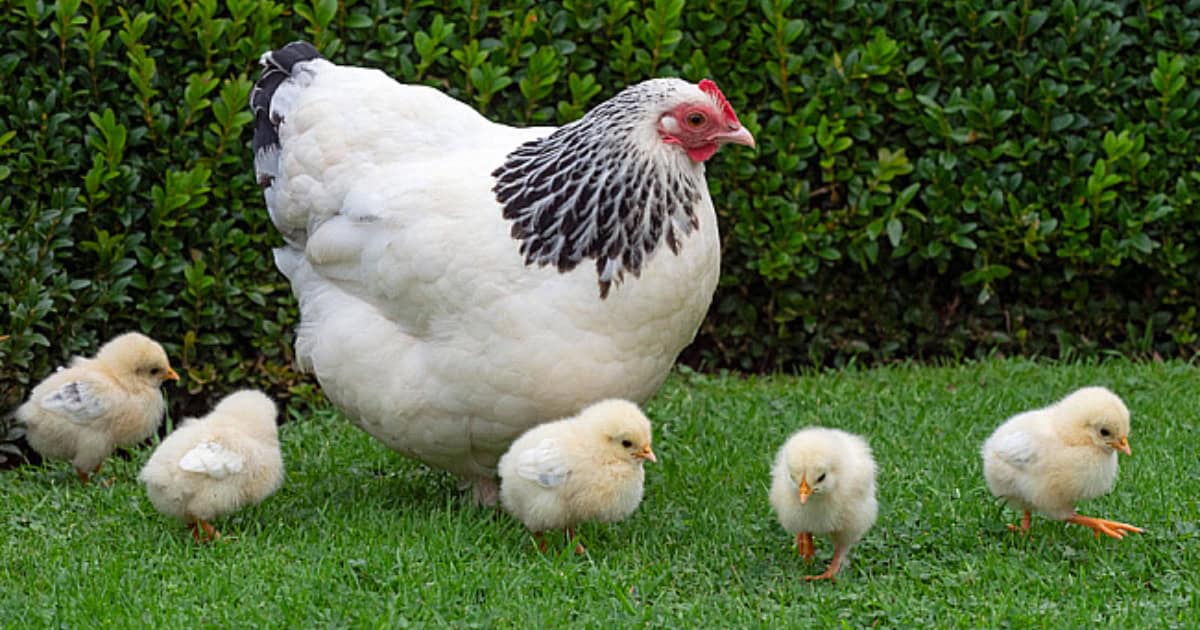Chickens, Info Guides
Sussex Chickens – A Complete Guide to the Popular Chicken Breed
Sussex chickens are a dual purpose bird. They make a great pet for backyard chicken keepers.
They are friendly and easy to handle, making them a good choice for families or beginners.
Sussex Breed Profile
Sussex are valued as being excellent dual purpose backyard chickens – they lay eggs consistently and their large size makes them suitable for meat production.
History of Sussex Chickens
The Sussex chicken is one of the oldest chicken breeds that is still around today.
They are believed to have originated in England around the time of the Roman invasion in 43 AD.
However, the original birds would have looked very different to the Sussex we know. They were then bred with chickens the Romans brought with them to help develop the breed.
In the Victorian era, chicken ownership suddenly spiked in popularity. Many people who had never owned birds before were now poultry enthusiasts.
This was referred to as Hen Fever and is believed to have been inspired by Queen Victoria’s love of poultry.
Many new chicken breeds were introduced to England and used to mix with the existing breeds.
It is believed Sussex chickens had Brahmas, Cochins and Dorkings mixed in with them to create the modern Sussex we know today.
The Sussex chicken was hugely popular in England’s Sussex, Kent and Surry counties. Suppliers from these areas brought Sussex chickens to the London markets, which helped spread them across Great Britain.
In 1845, the first ever poultry show was held in London. Sussex chickens were one of the breeds exhibited and were referred to as ‘Sussex/Kentish Fowl’. The exhibition helped to recognise them as a breed and grow their popularity even more.
For a long time, Sussex were the most popular table bird. However, in the 1950’s as the broiler industry grew, heritage breeds such as the Sussex began to decrease in demand.
The Livestock Conservancy continued to breed Sussex to keep the breed in existence.
Today, Sussex are prized by backyard chicken owners but are less popular in the commercial egg or broiler industries.
Sussex Chicken Breed Standards
Colour Varieties
Sussex chickens come in a wide variety of colours. The first three Sussex varieties created were the:
Speckled Sussex Chicken
The Speckled Sussex has chestnut coloured feathers with a black and white speckled pattern all over. Their speckled pattern will usually become more noticeable after each molt.

Speckled Sussex
Black & white speckled pattern all over
Light Sussex Chicken
The Light Sussex has a white body and head. They have a black neck and black tail feathers.

Light Sussex Chicken
They lay large eggs that are cream to light brown in colour
Red Sussex Chicken
The Red Sussex has dark, reddish-brown feathers. It is rare. These are the only varieties currently recognised by the American Poultry Association.
The below colour varieties are recognised by the Poultry Club of Great Britain, in addition to the original three:

Red Sussex Chicken
They have dark reddish-brown feather colour making them easily recognisable
Brown Sussex Chicken
Brown Sussex have dark brown feathers with a black, partridge pattern. They are rare.

Brown Sussex Chicken
They have dark or light brown feather colours and is one of the most productive breeds of poultry
Buff Sussex Chicken
Buff Sussex are a beige colour with black markings on their hackle feathers and tail. They are rare.

Buff Sussex Chicken
Their heads and necks are buff in colour and striped with a greenish-black with black accents on their wings
White Sussex Chicken
White Sussex look very similar to Light Sussex. Their feathers are a brighter, pure white.
They have a small amount of black on their neck and tail but much less than the Light Sussex does.

White Sussex Chicken
Their plumage is snow white from one end to the other
Silver Sussex Chicken
Silver Sussex have a black body with silver penciling on their breast, neck and head. They are rare.

Silver Sussex Chicken
They feature a white head, neck, and saddles that are striped with black
Coronation Sussex Chicken
Coronation Sussex are similar to the Light Sussex hen however their neck and tail feathers are lavender, rather than black.
They were developed in 1937 for the Coronation of Edward VIII (who abdicated before the coronation could take place).
This variety died out but was re-created in the 1980’s.

Coronation Sussex Chicken
Their heads and necks are white in colour and striped with blue a soft blue-grey colour
Size
The Sussex is a large breed, making them a suitable table bird. A Sussex hen weighs around 3.5kg while a Sussex rooster weighs around 4.5kg.
Bantam Sussex were developed in the 1920’s. Bantam hens weigh around 1.1kg and bantam roosters weigh around 1.5kg.
Appearance
Sussex have a heavy, rectangular shaped body with a broad back and wide shoulders.
They have soft, close fitting feathers. Their perky tail sticks out at a 45 degree angle. All varieties have a red single comb with red wattles and earlobes.
They have clean, light coloured legs with 4 toes on each foot. Their eyes are orange or red, depending on the variety.
Eggs
Sussex hens are known for their egg laying capabilities. This is one reason they are such a popular choice for a backyard chicken keeper.
Egg Color and Size
Sussex hens lay large eggs. They are light brown in colour.
Egg Laying
Sussex hens can lay between 200-250 light brown eggs per year. That is around 4 eggs per week per hen!
They usually begin laying at around eight months old, which is later than other breeds.
Sussex are a great breed if you want eggs all year around. Unlike many other chickens, their egg laying will continue through the cold, winter months.
However, it will realistically slow down a bit until spring-time when it warms back up again.
The only time they will stop laying is when they are molting, as all chickens do. During molting time, chickens are using all their nutrients to replenish their feathers and are unable to also produce eggs.
Think of it as a time for them to recharge and come back to laying feeling refreshed.
They will lay the most eggs within the first few years of their life. Egg production will gradually begin to slow down when they are around five years old, laying less and less as they age.
Sussex Chickens as Pets
Sussex not only supply your family with fresh eggs but make great pets too. They are friendly and suitable to be kept by families with children.
They are low maintenance and therefore a good chicken for beginners. They are a hardy breed and suitable to live in cold climates, such as their native England.
They are very talkative but not necessarily loud or annoying.
Temperament
Sussex are a confident yet docile breed. They are a graceful bird.
They are happy to be around humans. This makes them easy to approach and handle.
They don’t mind being held, making them suitable for an older person or young child to handle. They enjoy a pat however are just as happy on their own. They are too independent to be classed as a ‘lap chicken’.
They are very curious – if you are spending time out in the garden, they will often come over just to see what you are up to!
Their non-aggressive nature means that if you mix them in a coop with other breeds, they will be at the bottom of the pecking order. This means they get bullied or attached by more confident flock members.
You can minimise fighting by only mixing them with other docile breeds that are a similar size to them and ensure they all have plenty of room in the coop to get away from one another if they want to.

Sussex Chicken Breed Temperament
Their non-aggressive nature means that if you mix them in a coop with other breeds, they will be at the bottom of the pecking order
Caring for your Sussex Chicken
Sussex are an easy breed to care for.
They love to peck around and forage for food in the yard, eating seeds and bugs that give them lots of extra nutrients. This also helps keep their feed bill minimal.
Sussex are prone to weight gain, as they were bred to be a table bird. For pet chickens, this can lead to obesity and other related health issues.
You will need to keep an eye on their weight and limit treats.
Whilst they prefer cold climates, Sussex can also handle warmer areas as long as you provide them with plenty of shade and cool water.
On hot summer days, freeze water in big bottles and sit them in the coop to help cool them down.
If you have any chicken health concerns, always contact a professional vet for advice.
Chicken Coops
Like most other breeds, Sussex can handle confined spaces but are much happier if you allow them to free range.
Most owners will have a chicken coop for them to go into at night time but then will let them out to free range in their yard during the day time.
When deciding what sized chicken coop to get, remember that Sussex are quite large and may need more room than what is recommended for the average hen.
Make sure the coop has enough space on the perches inside so they can all roost at night time.
The Somerzby Homestead shown below is the perfect choice for housing your Sussex chickens.
Somerzby Homestead Chicken Coop
The Homestead features easy clean and access with a new walk-in design and complete opening door suitable for up to 12 chickens
If you are planning to keep your chickens in their coop full time, you will need to purchase a much bigger coop with a large run area.
Always lock your chickens into their coop at night for protection. Choose a coop with strong wire mesh to keep out predators such as foxes.
When buying a chicken coop, think about how you will clean it. The easier it is to clean, the more often you are likely to do it. Features such as large opening doors and sliding metal trays make cleaning much simpler.
Nesting Boxes
A Sussex hen will prefer to lay her eggs in a nesting box, as it helps her to feel protected while she is laying her eggs.
Nesting boxes will also benefit you as a chicken owner! You will always know where to look to find their eggs without having to search the whole yard and risk stepping on them.
Somerzby coops all come with nesting boxes mounted onto the side with an opening lid.
This makes daily egg collection easy as you don’t need to go inside of the coop to retrieve them.
Provide one nesting space for every three hens. Some people think you need one nesting space per hen but that is incorrect – they won’t all lay at the exact same time and are happy to take turns and share.
Breeding
Sussex are a broody breed and therefore suitable to use to hatch fertile eggs. If you allow them to mother the chicks, they are very protective of their babies.
Some people say the Light Sussex hen is less likely to go broody than the other varieties but this will vary from bird to bird.
Sussex Rooster
Sussex are so friendly that even the roosters are fairly docile. However, like all roosters, they are still prone to becoming aggressive.
They are likely to be worse during breeding season.
If you are considering getting a rooster as part of your backyard flock, make sure you are prepared for if it does become aggressive.
Some will grow spurs on their feet which could injure you or your hens. They also crow loudly in the mornings which may annoy your neighbours.
Sussex Hen
On the other hand, Sussex are a very easy-going and docile hen. They will provide eggs for you whilst also being easy to care for and handle.
For this reason, the average chicken keeper will only keep hens as part of their flock.
Chicks
Sussex chicks are exactly what you imagine when you think ‘baby chicken’ – small, yellow and fluffy!
Within the first two weeks, Light Sussex will start to show the black markings on their neck and tail slightly.
Usually within six weeks, Sussex chicks will have feathered out and will be showing their true feather colours. They are then ready to leave the warmth of their brooder.
Speckled Sussex (particularly a Speckled Sussex hen) will mature slower than all the other varieties.

Sussex Chicks
Within the first or second, Light Sussex will start to show the black markings on their neck and tail slightly.
Buying
Sussex are a very popular breed in Australia. The Light Sussex and Speckled Sussex are the most commonly found and therefore will be cheaper than other varieties.
You can purchase Sussex chickens from poultry breeders or farm supply stores. Some sellers can transport the chickens to you for an extra fee.
When buying chickens online, beware of scammers. If you aren’t sure if a website is legitimate, look at reviews online or phone the company to ask questions.
Since COVID first hit Australia, the demand for chickens has increased and therefore the price has gone up too. This includes the usually cheaper Light Sussex chickens.
Point of lay Sussex hens (around eight months old) usually cost around $40.
Baby Sussex chicks will cost around $20 per chick. You will need a brooder to keep them constantly warm.
You will also need to keep them separated from adult birds until they are big enough to defend themselves. There is a risk you may end up with unwanted roosters.
The cheapest way is to buy fertile Sussex eggs at around $40 per dozen. However, you will also need to invest in an incubator.
This can take a lot of time and effort, and it isn’t guaranteed that they will all hatch.





